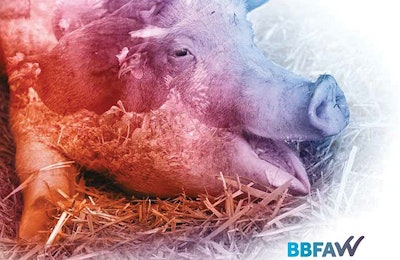
Sixty percent of the world’s leading food companies have formal farm animal welfare policies and appropriate management processes for ensuring that they are effectively deployed internally and throughout their supply chains.
The finding comes from the latest edition of the Business Benchmark on Farm Animal Welfare (BBFAW), supported by Compassion in World Farming (CIWF) and World Animal Protection, and which analyses 150 global food companies.
While there is “an appetite and a willingness” among leading food businesses to give greater importance to welfare, say the report’s authors, more work needs to be done to ensure that policies are properly applied on the ground. Welfare may have become integral to business strategy for a growing number of companies, but most still need to do more.
Global scope
Companies in 23 countries were evaluated for the latest edition, with 34% based in Europe (excluding the U.K.), 33% from North America, 13% from Asia and the same number from the U.K., and 7% from Latin America.
Across these regions, 63 food producers with combined revenues of US$500 million were analyzed, along with 52 retail and wholesalers and 35 restaurants and bars.
The analysis examined farm animal welfare management and performance across 37 distinct, objective criteria, with companies measured and scored on their approach to management commitment and policy, governance and policy implementation, leadership and innovation and performance reporting and impact
Based on these overall scores, companies are then divided into tiers:
To achieve Tier 1 status, a company must have a percentage score over 80 and is classified as having a welfare leadership position.
To achieve Tier 2, a company’s score must be 62-80%, and it is deemed to have made welfare an integral part of its business strategy.
Tier 3 status equates to a score of 44-61%, with a company having an established approach to farm animal welfare but needing to do more to ensure effective implementation.
Tier 4 status requires a score of 27-43% and is awarded to companies making progress on policy implementation and welfare commitments.
Tier 5 status is for those companies scoring 11-26% and that have identified farm animal welfare as a business issue, but provide limited evidence that the issue is being effectively managed, while Tier 6 is for companies scoring under 11%, with little, if any, evidence that welfare is recognized as a business issue.
Welfare in a competitive environment
Of the examined businesses, 104 (69%) now report at least some sort of animal welfare performance data. For example, 12 companies report that 100% of the laying hens in their supply chains are free from close confinement, while eight companies report that pigs in their supply chains are free from sow stalls/gestation crates. Three companies report that more than half of the broiler chickens in their supply chains are kept at below a maximum stocking density of 30 kg/m2.
According to Abigail Herron, global head of responsible investment with asset management company Aviva Investors, the 2019 benchmark reveals how some leading companies are demonstrating that action on animal welfare is possible within a competitive environment.
However, she continued that, while the average number of companies that are considered to have farm animal welfare as an integral part of their business strategy has grown significantly over the eight benchmark cycles from three (out of 68) in 2012 to 22 (out of 150 in 2019), more still needs to be done.
Her comments were echoed by Nicky Amos, executive director for the BBFAW, who added that BBFAW’s company and investor surveys revealed that customer interest in animal welfare is the primary driver for business action for 79% of companies, while 82% of investors consider welfare to be an investment risk.
“Companies that fail to take responsibility for ensuring the welfare of animals farmed for food can expect heightened scrutiny from their business customers and partners, from investors and customers," she said.
Time to improve
The overall average score for performance reporting among the companies detailed in the BBFAW is only 15%, while many low-ranking companies have not improved their ranking at all over the time they have been studied. The low figure for performance reporting, for example, suggests that while companies may have strengthened their farm animal welfare systems and processes, they are yet to translate this effort into improved welfare outcomes.
Forty percent of the 150 companies still appear in the bottom tiers of the ranking, with little or no information about how they are managing the risks and opportunities associated with farm animal welfare.
Benchmark’s authors note that, while they recognize that it takes time for companies to reach a stage where they are confident in the data they report, there ought to be improved scores in this section of the Benchmark in the future.

Nicky Amos, executive director for the BBFAW warned that for companies to fully consider animal welfare they can expect greater scrutiny from consumers and investors alike. | Courtesy CIWF
















